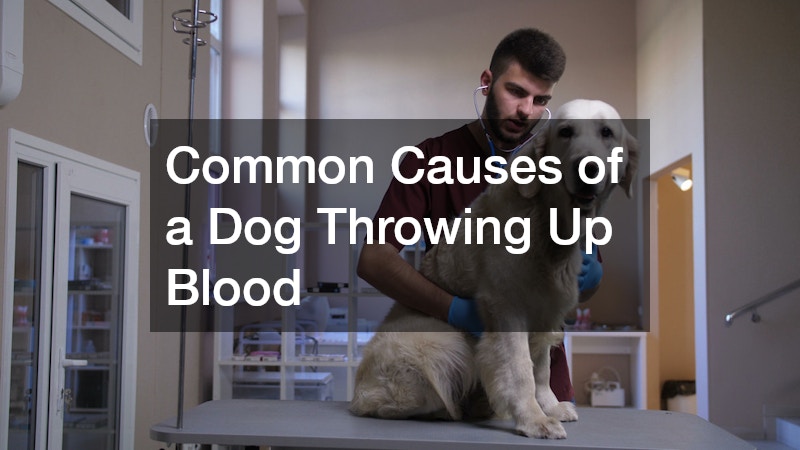Is Your Dog Throwing Up Blood? Learn the Signs, Causes & Solutions

Seeing your dog throw up blood is scary. Whether it’s a few red streaks or a large amount, blood in vomit is a sign that something is wrong. Some causes are minor and easy to treat. Others are serious and need fast action. In this guide, we’ll explain what to watch for, what might be causing it, and when to call the vet.
What Does Blood in Vomit Look Like?
Blood in dog vomit doesn’t always look the same. Depending on where it’s coming from and how long it’s been in the body, it can look different.
Bright Red Blood
This means the bleeding is recent and likely coming from the mouth, throat, or upper digestive tract. You may see streaks or splashes of red in otherwise normal-looking vomit.
Dark or Coffee Ground-Like Blood
If the blood looks dark brown, black, or like coffee grounds, it means the blood has been in the stomach and partly digested. This usually points to bleeding in the stomach or small intestine and can be more serious.
Common Causes of a Dog Throwing Up Blood

Many things can cause a dog to vomit blood. Below are the most common reasons:
1. Stomach Ulcers
Ulcers can form in the stomach due to stress, medications, or illness. These small wounds can bleed and cause dark, bloody vomit.
Signs:
- Dark or tarry vomit
- Lack of appetite
- Lethargy
Common triggers:
- NSAIDs (like Rimadyl or aspirin)
- Steroids
- Stress
- Chronic vomiting
2. Ingesting Foreign Objects
Dogs love to chew on things, but if they swallow sharp objects like bones, sticks, or toys, it can tear their throat or stomach lining.
Signs:
- Gagging or choking
- Pain when touched around the belly
- Bloody vomit or drooling
3. Toxins or Poisoning
Toxic substances like rat poison, chocolate, or antifreeze can cause internal bleeding. This is a medical emergency.
Signs:
- Bloody vomit and/or diarrhea
- Tremors or seizures
- Pale gums
- Collapse
4. Severe Vomiting or Coughing
If your dog vomits or coughs too hard, it can cause small tears in the throat, leading to streaks of blood in the vomit.
Signs:
- Mild bleeding
- Recent illness or coughing fits
- Usually goes away on its own
5. Infections
Bacterial or viral infections, such as parvovirus, can damage the digestive lining and cause bloody vomit and diarrhea.
Signs:
- Vomiting and diarrhea
- Fever
- Lethargy
- Not eating
Puppies are especially at risk and should see a vet immediately.
6. Parasites
Worms like hookworms can attach to the stomach or intestines and suck blood, which may show up in vomit or stool.
Signs:
- Vomiting with blood
- Diarrhea
- Weight loss
- Bloated belly in puppies
7. Cancer or Tumors
Growths in the stomach or esophagus may bleed, especially in older dogs. Tumors can be benign or cancerous.
Signs:
- Vomiting with or without blood
- Weight loss
- Weakness
- Change in eating habits
8. Blood-Clotting Disorders
Some dogs have issues with how their blood clots, whether from disease or poison. This can cause bleeding in different parts of the body, including the stomach.
Signs:
- Bloody vomit
- Nosebleeds or bloody urine
- Bruising easily
9. Heatstroke
Dogs that get too hot can suffer internal damage, including bleeding in the gut. This is more common in hot climates or during summer exercise.
Signs:
- Heavy panting
- Bright red tongue
- Vomiting blood
- Collapse
Other Symptoms to Watch For

If your dog is throwing up blood, it’s important to look for other symptoms that could help your vet figure out the cause.
- Diarrhea (including dog pooping blood)
- Lethargy
- Fever
- Pale gums
- Loss of appetite
- Dehydration
- Shaking or trembling
- Abdominal pain
- Weight loss
Important: If your dog shows more than one of these symptoms along with vomiting blood, call your vet immediately.
What to Do If Your Dog Is Throwing Up Blood
1. Don’t Panic, But Act Fast
Stay calm, but don’t wait too long. Even small amounts of blood can be a sign of something serious.
2. Check for Other Symptoms
Look at your dog’s behavior, gums, poop, and energy level. This helps your vet make a faster diagnosis.
3. Call Your Vet
Describe everything clearly: when the vomiting started, what the blood looked like, what your dog ate recently, and any other changes in health.
4. Follow Instructions
Your vet might suggest bringing your dog in right away or watching them at home. Don’t give your dog food, water, or human medicine without asking first.
Diagnosis: What the Vet Will Do
To find out what’s wrong, your vet may do:
- A physical exam
- Blood tests
- Fecal tests (especially if dog pooping blood too)
- X-rays or ultrasounds
- Endoscopy (camera into the stomach)
Treatment Options
Treatment depends on what’s causing the bleeding.
For Ulcers or Inflammation:
- Medications to reduce acid
- A bland diet
- Discontinuing harmful meds
For Parasites:
- Deworming medications
- Follow-up fecal tests
For Infections:
- IV fluids
- Antibiotics or antivirals
- Hospitalization (for severe cases like parvo)
For Foreign Objects:
- Inducing vomiting (if recent)
- Surgery to remove the object
For Toxins:
- Activated charcoal
- Antidotes
- Intensive care
For Tumors or Cancer:
- Surgery
- Chemotherapy
- Palliative care if needed
Can It Be Prevented?
While you can’t stop all causes of bloody vomit, there are steps to help lower your dog’s risk:
- Keep trash and unsafe foods out of reach
- Avoid giving your dog sharp bones or toys
- Use vet-approved flea, tick, and worm preventatives
- Don’t give your dog human medications without approval
- Schedule regular vet checkups
- Watch for signs of stress or digestive issues early
When to See the Vet Immediately
Call your vet or go to the emergency vet if your dog:
- Vomits blood more than once
- Seems weak or collapses
- Has pale gums or trouble breathing
- Has both bloody vomit and bloody stool
- Hasn’t eaten or drunk in 24 hours
Quick treatment can save your dog’s life.
Final Thoughts
Seeing your dog throwing up blood is scary—but the good news is, many causes are treatable, especially if caught early. Always contact your vet if you’re unsure. Pay attention to other signs, and never ignore changes in your dog’s eating, bathroom habits, or energy. Your dog depends on you to notice when something isn’t right—and take action to keep them healthy and happy.

